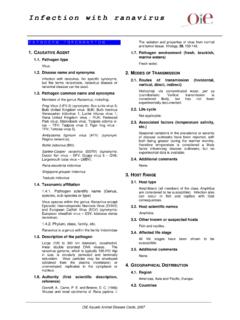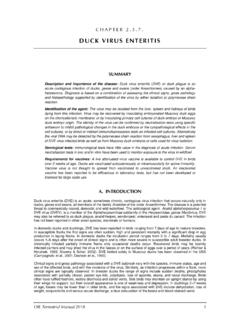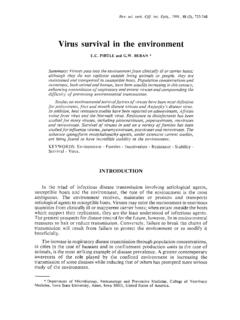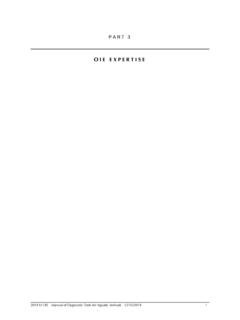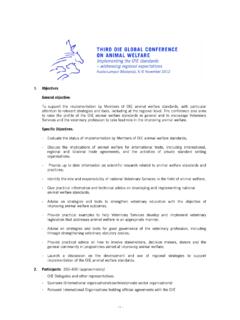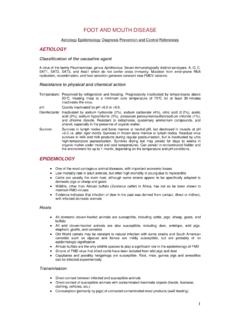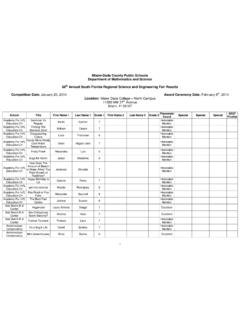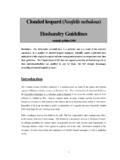Transcription of Avian Influenza Importance - Home: OIE
1 Avian Influenza Importance Avian Influenza viruses are highly contagious, extremely variable viruses that are widespread in birds. Wild birds in aquatic habitats are thought to be their natural Fowl Plague, Grippe Aviaire reservoir hosts, but domesticated poultry are readily infected. Most viruses cause only mild disease in poultry, and are called low pathogenic Avian Influenza (LPAI) viruses. Highly pathogenic Avian Influenza (HPAI) viruses can develop from certain LPAI. Last Updated: September 2014. viruses, usually while they are circulating in poultry flocks. HPAI viruses can kill up to 90-100% of the flock, and cause epidemics that may spread rapidly, devastate the poultry industry and result in severe trade restrictions.
2 Infection of poultry with LPAI. viruses capable of evolving into HPAI viruses also affects international trade. Avian Influenza viruses occasionally affect mammals, including humans, usually after close contact with infected poultry. While many human cases are limited to conjunctivitis An enhanced version of or mild respiratory disease, some viruses tend to cause severe illness. In rare cases, this factsheet, with citations Avian Influenza viruses can become adapted to circulate in a mammalian species, and is available at these viruses have caused or contributed to at least three pandemics in humans. Factsheets/pdfs/highly_patho Etiology genic_avian_influenza- Avian Influenza results from infection by viruses belonging to the species Influenza A virus, genus influenzavirus A and family Orthomyxoviridae.
3 Influenza A. viruses are classified into subtypes based on two surface proteins, the hemagglutinin (HA) and neuraminidase (NA). At least 16 hemagglutinins (H1 to H16), and 9. neuraminidases (N1 to N9) have been found in viruses from birds, while two additional HA and NA types have been identified, to date, only in bats. The viral HA, and to a lesser extent the NA, are major targets for the immune response. There is ordinarily little or no cross-protection between different HA or NA types. Influenza viruses in birds are classified as either low pathogenic (also called low pathogenicity) or highly pathogenic (high pathogenicity) Avian Influenza viruses. A.
4 Virus is defined as HPAI or LPAI by its ability to cause severe disease in intravenously inoculated young chickens in the laboratory, or by its possession of certain genetic features associated with HPAI viruses. To date, the fully virulent HPAI viruses found in nature have always contained H5 or H7, although there are rare examples of other viruses that could technically be considered HPAI. Antigenic shift and drift in Influenza A viruses Influenza A viruses are very diverse, and two viruses that share a subtype may be only distantly related. Some variability results from the gradual accumulation of mutations, a process called antigenic drift.' Once the viral HA or NA has changed enough, immune responses generated against its former proteins may no longer be protective.
5 More rapid changes can occur when two different Influenza viruses infect the same cell. In this situation, gene segments from both viruses may be packaged into a single, novel virion, a process called genetic reassortment. Genetic reassortment can occur between any two Influenza A viruses, whether they are adapted to circulate in birds or mammals. If genetic reassortment results in the acquisition of a new HA. and/or NA protein, this can cause an antigenic shift' among the viruses circulating in a species. Antigenic shifts may be sufficient for the reassortant virus to completely evade existing immunity. After a subtype has circulated in a species for a while, genetic reassortments and antigenic drift can produce numerous viral variants, which may differ in their virulence for birds and/or mammals.
6 Species Affected The vast majority of LPAI viruses are maintained in asymptomatic wild birds in aquatic habitats. These birds are thought to be their natural reservoir hosts. Infections are particularly common among members of the order Anseriformes (waterfowl, such as ducks, geese and swans) and two families within the order Charadriiformes, the Laridae (gulls and terns) and Scolopacidae (shorebirds). Some aquatic species in other orders might also be maintenance hosts. LPAI viruses seem to be uncommon in most wild birds that live on land (terrestrial birds). However, these birds can also become. 2006-2014 page 1 of 24. Avian Influenza infected if they are exposed.
7 HPAI viruses are not normally sparrow and wild waterfowl. Whether wild birds play any found in wild birds, although a few subtypes have been role in spreading this virus is uncertain. Based on detected, and some have caused outbreaks. experimental infections, chickens and quail are most likely Domesticated birds can be infected by Avian Influenza to maintain this H7N9 virus, but several species of ducks, viruses, although susceptibility appears to differ between geese, pigeons, parakeets (Melopsittacus undulates) and species. Poultry are readily infected by both LPAI and various passerine birds could also be infected. There have HPAI viruses. When LPAI viruses from wild birds are been no reports of naturally acquired illnesses or infections transferred to poultry, they may circulate inefficiently and in mammals, as of September 2014.
8 In experimental die out; become adapted to the new host and continue to studies, isolates from humans could infect miniature pigs, circulate as LPAI viruses; or if they contain H5 or H7, they ferrets, laboratory mice and cynomolgus macaques. may evolve into HPAI viruses. Viruses that have adapted to Other Avian Influenza viruses reported in poultry rarely become re-established in wild birds, although mammals they may infect them transiently. Many different viruses In addition to H5N1 and H9N2 viruses, diverse can cause disease in chickens and turkeys, but three viral subtypes ( , H4, H5N2, H6N6, H7, H10N5 and H11N2). lineages are currently of particular concern.
9 Have been detected occasionally in pigs, especially in Asia. Asian lineage H5N1 Avian Influenza viruses An H10N4 virus was responsible for an epidemic in farmed The A goose Guangdong 1996 lineage ( Asian lineage') mink, and experimental infections with several other Avian of H5N1 HPAI viruses seems to have a particularly wide subtypes have been established in this species. One Avian host range. In addition to domesticated birds, these viruses H3N8 virus affected horses in China for a short time. Cats have been found in a large number of wild or captive Avian and dogs can also be infected experimentally with some species. Whether wild birds can maintain these viruses for LPAI and/or HPAI viruses, and a clinical case caused by an long periods (or indefinitely), or are repeatedly infected H5N2 HPAI virus (related to Asian lineage H5N1 HPAI.)
10 From poultry, is still controversial. Asian lineage H5N1 viruses) was reported in a dog. Domesticated guinea pigs in HPAI viruses can also infect many species of mammals, South America had antibodies to H5 Influenza viruses. Few and their full host range is probably not yet known. To date, studies have investigated wild animals; however, antibodies they have been found in pigs, housecats, several species of to a few subtypes have been found in raccoons, and large felids in zoos, dogs, donkeys, stone martens (Mustela experimental infections were established in raccoons, foina), raccoon dogs (Nyctereutes procyonoides), palm skunks and wild mice (Mus musculus).

